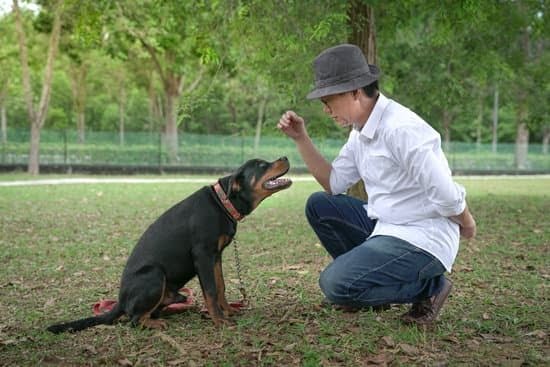Introduction
Becoming a dog trainer can be a rewarding and fulfilling experience. Dog trainers help owners to create better relationships with their pets and teach them commands or provide tips for taking care of their pup. In addition, there are a number of advantages that come with being a professional dog trainer, such as having flexible working hours, the ability to choose the type of training methods used, the opportunity to travel and work with a variety of breeds and types of dogs, as well as receiving positive feedback from clients you have helped. Furthermore, being a successful dog trainer can lead to many other career opportunities in the pet industry. You may even end up becoming an animal behaviorist or start your own pet-related business! When you become a certified dog trainer, you will also join an exclusive network of professionals who are devoted to improving the lives of their canine friends.
Education and Training Requirements
If you would like to learn to be a dog trainer, there are certain education and training requirements that must be met. It is essential that you understand the principles of animal behavior as they relate to dogs in order to become a successful trainer. Therefore, most trainers take classes in behavior modification, basic obedience training techniques, and canine health and nutrition. Additionally, those looking to become certified dog trainers will likely need to complete a one-year program before taking a written exam administered by an appropriate certifying body. It is also highly suggested that any potential trainers gain relevant supervised experience working with dogs either through internships or apprenticeships. This will not only allow future trainers to gain hands-on experience that can help deepen their knowledge base but also give them a chance to develop professional relationships within the industry. Upon completion of your coursework and other requirements, you should have all the necessary skills and knowledge needed for success in the field of dog training.
Developing an Effective Training Program
One of the most important skills a dog trainer needs to have is the ability to create an effective training program. This program should be tailored to the individual needs of each dog and include elements that will help them understand and practice new concepts. First, you should identify your client’s goals for their dog, such as teaching basic obedience commands, improving behavior in social situations, or increasing agility drills. Once those goals are established, you can start designing a training plan accordingly. The program should include commands such as sit, stay, come, leave it, etc., as well as activities like fetch games that can help with learning motivation and encourage better focus. Additionally, it is important to reinforce good behaviors with positive reinforcement strategies like praising good behavior and giving treats while discouraging bad behaviors without physical punishment or yelling. Lastly, remember to be consistent in your instructions and patient in working through any difficulties that arise along the way. With these steps in mind you will be able to craft an effective training program for any canine companion!
Knowing Your Market
In order to be a successful dog trainer, it is important to understand the market and the services you can offer. Before beginning your career as a dog trainer, you should research local demand, identify any unique niche markets you may be able to tap into, and assess what services you can offer that meet the needs of potential customers. Think about the types of services people in your area want. While basic obedience training is often requested, some urban areas might need someone who specializes in working with large breeds or city life behavior adjustment. Additionally, consider expanding your range of services beyond basic obedience training and teaching specialized classes like puppy socialization classes or therapeutic programs to work with dogs recovering from abuse. It is also important to think about whether you would like to use traditional or reward-based methods for training and take care of any necessary legal paperwork such as registering as a business or obtaining professional liability insurance. For many dog trainers, offering useful resources in addition to their services is essential; this could include selling books or speaking engagements at pet stores or veterinary offices. Understanding the market and what service it needs is key when learning how to be a successfuldog trainer.
Finding and Managing Clients
Dog trainers have an exciting job working with dogs and their owners. Becoming a successful dog trainer requires time, commitment, and knowledge. A great way to start getting clients is to market yourself by advertising and networking within the community.
Advertising can take many forms such as placing ads in newspapers or magazines, distributing leaflets, or creating a website about your training services. It’s also important to be properly certified and insured as a dog trainer so clients are confident in your services. Networking can be done in person or online by attending pet-related events or joining discussion forums within the industry. Both advertising and networking will help you spread the word about your services and set yourself apart from other trainers in the area. Additionally, gaining positive reviews can also be beneficial for gaining new clients as people are more likely to trust recommendations from previous customers. Finally, consider signing up with an agency who has access to potential clients who may not otherwise find you on their own.
In addition, building strong relationships with local veterinarians is essential for connecting with potential clients who may need assistance training their pets. Developing contacts at grooming salons and pet stores can also create business opportunities, as those establishments often have connections with people searching for trainers that specialize in certain breeds or styles of training methods such as clicker/positive reinforcement training or obedience classes/exercises. Furthermore, offering ‘meet-and-greet’ sessions at dog parks is a fantastic way of meeting fellow dog owners who may be interested in hiring your services when they have difficulty teaching their pet basic commands such as sit, stay, or come when called; reinforcing house rules; managing separation anxiety; providing adequate exercise; etc. Creating an informative newsletter outlining the different types of dog training available along with small case studies emphasising the efficacy of these methods can also prove helpful for buying potential customers given it will provide them with firsthand experience into how trainable unwanted behaviour problems such as aggression toward other animals or humans can become manageable given professional guidance built upon trust between seller and buyer alike via open communication amidst operating on sound moral principles at all times.
Setting Boundaries
As a dog trainer, it is important to provide clients with a detailed contract that outlines your services, including any restrictions or limits. This document should be concise and clear, but also comprehensive enough to address all areas and potential issues arising from a training relationship. Here are some of the key areas that should be included in any dog training contract:
• Fees and payment schedule. This section should include pricing for each service offered as well as whether there will be additional fees beyond the initial fee for particular items such as extra training sessions, home visits, or other services. You may also want to include clause here regarding late payments and the possible consequences of non-payment after an agreed upon time.
• Scope of services. In this section you will outline what types of activities you plan to do with the client’s pet (such as obedience work) and how often the services will take place (i.e., weekly). It is also important to include information about any assessments or evaluations that need to be done prior to beginning a project.
• Scheduling needs/cancellation policy. You should cover how often you are available for sessions as well as when changes need to be made on both sides in order for them not to incur penalties (such as confirming cancellations at least 24 hours ahead of time). This clause should also include clarification on whether or not make up classes will be available if necessary.
• Risk management statement/liability waiver. Obviously, there are risks involved when working with animals which can increase if proper precautions are not taken by both parties involved, so it is important to state clearly who will assume liability in case of injury or damage caused during a session or while caring for the animal outside of one.
• Owner agreement statement. This acknowledges that the owner has read and understood all materials provided by a professional dog trainer and agrees with all outlined services and policies set forward in the contract
What to Expect During Training Sessions
Dog training sessions typically consist of a series of commands and/or behaviors for your dog to learn and practice. During the session, you will teach your dog cues such as sit, stay, come, and heel. You’ll also work on behaviors like waiting at the door before being allowed outside, wait for food until told it is okay to eat, chew the appropriate toys instead of furniture, stop barking or other nuisance behaviors and perhaps even perform tricks. Managing the environment will also be important with alluring items like treats placed out of range so that your pup not get too distracted during lessons. Additionally, reward-based techniques will be used in order to encourage positive reinforcement when your canine companion learns something correctly. Afterward, these commands and behaviors can then be practiced regularly throughout their life as good manners are essential components in any well-behaved pup!
What to Do When Training doesn’t Go as Planned
If you find yourself in a situation with your dog and training isn’t going as planned, it’s important that you don’t give up. It’s important to keep your patience despite any frustration you may feel. Take a few deep breaths and analyze the situation. Look for signs of confusion or agitation in your dog’s behavior so that you know where to begin when trying again.
There are some other tricks you can use as well if training doesn’t seem to be going your way. If a session doesn’t yield the desired results, plan on shortening the length or frequency of them; too much repetition can lead to boredom or overload. Making the tasks more interesting is a great way to recapture your dog’s interest. This means throwing in an extra command like rolling over, asking him to stay seated while fetching items, making him jump over obstacles, or even shaking hands with visitors who come into your home.
You can also vary the methods used during each session. For example, some dogs are visual learners and may do better with hand signals rather than verbal commands – so try switching up between both options! Practicing basic obedience skills on walks is another great idea; since those settings tend to have more environmental distractions, it could help reinforce the behaviors being taught more effectively than in a dull indoor setting! Finally, make sure you provide lots of encouragement and rewards for good behavior using treats and praise – this will keep both of you motivated!
Understanding Different Breeds and Temperaments
When learning to be a dog trainer, it is important to understand that every breed and individual dog has its own unique temperament. Taking the time to get to know each breed and/or each dog before starting training sessions is an important step in ensuring successful outcomes. Different breeds of dogs have certain characteristics which are common among members of the same type. It is helpful to learn these common traits and anticipate how they may affect training. For instance, herding breeds such as collies may be more herd-oriented during training sessions and might benefit from exercises involving problem-solving skills; whereas working breeds like huskies may need larger allowances for energy output in their daily routine. Additionally, each dog will have its own unique traits that may influence its effectiveness with different types of training techniques. Having a good understanding of these nuances will aid in customizing your training plan for the individual needs of each animal you work with.
Dealing with Difficult Clients and Difficult Dogs
When you learn to be a dog trainer, one of the most important and challenging aspects of the job is dealing with clients who have difficult dogs. Working with these unique cases may require more patience, determination, and creativity than more straightforward tasks. Understanding both the client and their pet’s needs, setting clear boundaries to ensure no harm comes to either party, and coming up with practical training solutions that work for everyone can make all the difference in achieving success.
Before attempting any intensive training with a difficult dog or client, it is important to determine why they may be having difficulty. Some common underlying issues that can cause behavior problems include boredom, anxiety, learned helplessness or aggression. A professional trainer should also take into account any past trauma, neglect or other unfortunate circumstances that may contribute to their current ordeal. Each case should be approached in an individualized way so as not to generalize it too much- different breeds or ages of dog often have separate sets of behaviors that need addressing.
From there, understanding how best to communicate efficiently can be invaluable when dealing with particularly challenging dogs and their owners. It is necessary to set realistic goals for both parties so they don’t become overwhelmed- this could mean breaking complex tasks down into more achievable sub-goals until the desired action becomes second nature for the dog. Constant positive reinforcement from both the owner and trainer like verbal rewards such as “good boy/girl!” will assist them in becoming successful at mastering commands over time – if applicable punishments are given out sparingly but with conviction; punishing bad behaviour constantly only serves to reduce trust levels between the pair unnecessarily. Finally staying flexible is key; constantly changing behaviour can come naturally for some pooches so adapting lessons accordingly gives them (and owners) optimism that their hard work does not go unnoticed!
The Benefits of Working as a Dog Trainer
Becoming a dog trainer can be both an exciting and rewarding career path. Working as a dog trainer comes with many wonderful benefits, such as providing you with the opportunity to work alongside our furry friends every day. Training dogs is an incredibly rewarding job that helps to ensure happier and healthier relationships between humans and their canine companions. In addition to improving canine-human relationships, working as a dog trainer allows you to build skills that promote trustworthiness, self-confidence, problem solving, effective communication and patience in yourself and others. Seeing the progress of pups from when they first come in for training to becoming more well-behaved, loyal pets is one of the best parts about being a dog trainer. Not only does it benefit owners who come in for help with their pet’s behavior but also develops your own teaching abilities over time. Another added benefit of being a professional dog trainer is the ability to work outside or at various locations such as veterinary offices or animal shelters on a part-time or full-time basis depending on your schedule needs. By combining advanced understanding of animal behavior with fun training techniques, you can teach obedience classes or offer specific behavioral coaching sessions while networking within the industry to continue expanding your client base. This allows you to do something you love while also earning money doing it!
Final Thoughts
As a professional dog trainer, you have the unique opportunity to make a difference in people’s lives—both animal and human. Not only do you get to teach canines all the necessary skills to thrive in their environments, but your work enables owners to have better relationships with their pets as well. By staying up-to-date on training techniques and understanding how animals learn, you can be effective and successful in this field. What’s more, by using positive reinforcement methods, you help create an environment of trust and mutual respect that is fostered through all your interactions with animals.
In addition to helping people and dogs form meaningful connections, being a dog trainer can also be lucrative. According to the U.S. Bureau of Labor Statistics, the median wage for trained animal behaviorists was $59,430 per year in 2018—a figure that is expected to increase faster than average over the next decade. So while it may take time and effort to gain certification as a dog trainer, many find their hard work pays off when they reap the rewards of stable job satisfaction and healthy compensation packages.
As a dog trainer, it is critical that you constantly strive for success by keeping up with industry trends and honing your craft each day through practice and engagement with supervisors or other colleagues who have been doing this work longer than you have. Embrace your career as a dog trainer and dedicate yourself fully to helping others experience the joys of adding a new pup into their lives – there’s nothing quite like being able to reach such meaningful goals each day!

Welcome to the blog! I am a professional dog trainer and have been working with dogs for many years. In this blog, I will be discussing various topics related to dog training, including tips, tricks, and advice. I hope you find this information helpful and informative. Thanks for reading!





